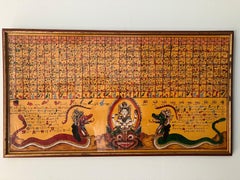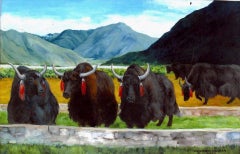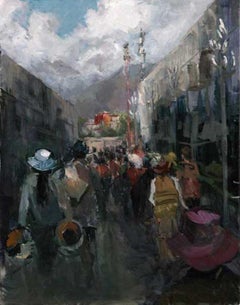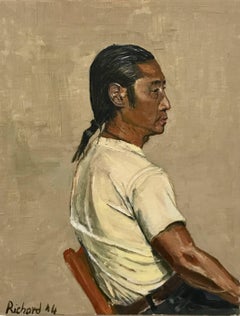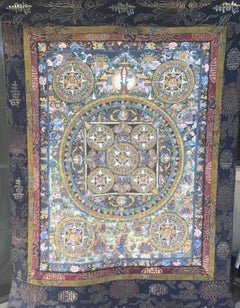Tibetan Oil Painting
Antique Tibetan School Painting
Located in San Francisco, CA
Fabulous antique original Tibetan school painting. Painting is either oil and or gouache. It
Category
Early 20th Century Figurative Paintings
Materials
Oil
Vibrant oil of Tibetan landscape "Yaks near Phasho" celebrates Tibetan animals
Located in Charleston, US
oil landscape and animal painting in Tibetan Himalayas, "Yaks Near Phasho" celebrates the bright
Category
21st Century and Contemporary Realist Landscape Paintings
Materials
Oil
Tibetan Festival in Shorton Prayer Flags OPA Oil Framed Lhasa
Located in Houston, TX
Paulette Lee was done onsite in San Francisco. It is oil painting on canvas.
In Southwest Art Magazine
Category
2010s American Impressionist Landscape Paintings
Materials
Canvas, Oil
H 24 in W 18 in D 1 in
Buddhist Novice from a Tibetan Monastery. Children, portrait, child, vertical
Located in Oslo, NO
"Buddhist Novice from a Tibetan Monastery" is a painting from the "Children of the World" series
Category
2010s Post-Impressionist Portrait Paintings
Materials
Canvas, Oil, Acrylic
Anna ShesterikovaBuddhist Novice from a Tibetan Monastery. Children, portrait, child, vertical, 2025
H 31.5 in W 23.63 in D 0.79 in
Recent Sales
Dorje. Original. Oil Paint on Board, Traveller, A Tibetan man, looking towards g
By Richard Burger
Located in London, GB
Dorje is an Original. Oil Paint on Board featuring a Traveller, Seated man with plaited hair
Category
21st Century and Contemporary Contemporary Portrait Paintings
Materials
Oil, Board, Ink
Antique Tibetan Thanka, Five Buddha Families and Avolokiteshvara (Chenrezig)
Located in Graton, CA
Here you have a beautiful 19th century Tibetan Thanka with the "Five Buddha Families" and
Category
Late 19th Century Other Art Style Figurative Paintings
Materials
Oil
Still Life with Tibetan Bowl
By Willard Dixon
Located in Burlingame, CA
Minimal Tibetan bowl still life scene with blue, brown and silver-gold. The calm zen like scene by
Category
21st Century and Contemporary Realist Still-life Paintings
Materials
Canvas, Oil
Portrait Of A Tibetan Terrier, 19th Century
By Maud Earl
Located in Blackwater, GB
19th Century portrait of a Tibetan Terrier, oil on canvas by Maud Earl. Fine example of the leading dog
Category
19th Century Portrait Paintings
Materials
Canvas, Oil
Portrait of a Tibetan Girl 'Figurative Oil on Canvas, Shanghai, 1997'
Located in Matosinhos, PT
Portrait of a Tibetan girl figurative oil on canvas, Shanghai, 1997
Beautiful oil on canvas
Category
1990s Tibetan Modern Paintings and Screens
Materials
Canvas
H 32.28 in W 28.34 in D 3.14 in
Blue Tibetan Painting on Paper
By Stephanie Wheeler
Located in Palm Beach, FL
room!
Blues with original oil painting underneath. The frame is a silver/gold tone mixed!
More
Category
2010s Abstract Mixed Media
Materials
Paper, Oil
Portrait Painting of Tibetan Mother and Child, Oil on Canvas
Located in SOMIS, CA
Beautifully depicting a Tibetan mother and her child, this painting brings Tibetan humanity to a
Category
20th Century Tibetan Paintings and Screens
Materials
Canvas
People Also Browsed
18th Century Tibetan Thangka Painting
Located in Chicago, IL
A rare striking 18th century Tibetan Thangka depicting the Green Tara seated on a lotus throne ready to step down to offer comfort and protection for all suffering beings. Her right ...
Category
Antique 18th Century Tibetan Tibetan Paintings and Screens
Materials
Linen, Paint
Get Updated with New Arrivals
Save "Tibetan Oil Painting", and we’ll notify you when there are new listings in this category.
Tibetan Oil Painting For Sale on 1stDibs
Surely you’ll find the exact tibetan oil painting you’re seeking on 1stDibs — we’ve got a vast assortment for sale. Find abstract versions now, or shop for abstract creations for a more modern example of these cherished works. Finding the perfect tibetan oil painting may mean sifting through those created during different time periods — you can find an early version that dates to the 19th Century and a newer variation that were made as recently as the 21st Century. When looking for the right tibetan oil painting for your space, you can search on 1stDibs by color — popular works were created in bold and neutral palettes with elements of gray, brown, beige and gold. Creating a tibetan oil painting has been a part of the legacy of many artists, but those crafted by Michelle Gagliano, Victor Wang, Hillary Gruenberg, Yu Hanyu and Allen Harrison are consistently popular. Artworks like these of any era or style can make for thoughtful decor in any space, but a selection from our variety of those made in paint, oil paint and fabric can add an especially memorable touch.
How Much is a Tibetan Oil Painting?
The price for a tibetan oil painting in our collection starts at $255 and tops out at $76,000 with the average selling for $6,490.
Questions About Tibetan Oil Painting
- 1stDibs ExpertOctober 12, 2021A traditional Tibetan Buddhist painting is called a Thangka. The painting is usually executed on cotton, and it may portray a Buddhist deity or mandala designs. Some Thangkas also depict the life of the Buddha. On 1stDibs, find a variety of Thangkas.
- 1stDibs ExpertFebruary 13, 2024To identify an oil painting, look closely at its surface. Compared to other paintings, pieces produced in oils usually show off a variety of textures across the canvas, and the paint will appear layered on. If you're looking to determine the name, age or creator of a work, try snapping a photo with your smartphone’s camera and conducting a reverse image search online. Shop a diverse assortment of oil paintings on 1stDibs.
- When was oil paint invented?1 Answer1stDibs ExpertFebruary 27, 2024Oil paint was invented during the 7th century A.D. The earliest examples of oil paintings have been traced to Afghanistan and depict scenes related to the Buddhist religion. Records dating back to the 12th century indicate that early Christian monks in Europe used oil paints to decorate furniture, and a century later, some artists began finishing tempera paintings with touches of oil paint. It wasn't until the 15th century that oil paints became a common medium for European painters, when Flemish artists like Jan van Eyck began favoring them over tempera. Explore a variety of oil paintings on 1stDibs.
- 1stDibs ExpertMay 3, 2024Jan van Eyck is widely considered by art historians to be the father of oil painting. While the usage of oil paints dates back to 7th-century China, the Flemish painter popularized the material, using oils to produce highly detailed works such as The Arnolfini Portrait. The Northern Renaissance master also influenced many other artists, such as Hugo van der Goes and Gerard David. Shop an assortment of fine art on 1stDibs.
- What is abstract oil painting?1 AnswerLilac Gallery Ltd.March 17, 2021An abstract oil painting and an artwork that is made with oil paint on a medium like canvas, wood board, or other panels like canvas board. And the 'abstract' term refers to the Movement & Style of the piece. As abstraction indicates a departure from reality in the depiction of imagery in art, the artist creates a painting where the subject, shape, form, color, and line, is created with no particular references of the world but as a composition that may exist with a degree of independence from its vision.
- 1stDibs ExpertMarch 22, 2024To maintain oil paintings that you purchased for your home, experts suggest that you keep them out of direct sunlight. Prolonged exposure to the sunlight coming in from a window can fade the colors in your painting. Do not hang your oil painting near a heat source or where it can get wet (bathrooms and kitchens are not safe for your oil painting).
You may wish to dust your oil painting so that layers of dust don’t begin to gather on its surface. This should only be considered to remove loose dust. Never spray any chemical substance on your oil painting. Do not use a damp cloth to dust your oil painting. (Again, your painting should not be exposed to moisture.)
To remove loose dust, use a soft brush that measures approximately one to two inches wide with natural-hair bristles. Do not use a dust cloth or a feather duster, as those items may catch or leave threads or feathers behind. Do not apply pressure or dust your painting for an extended period of time.
If you think that your oil painting is considerably dirty or believe that other issues may be at work, experts strongly suggest that you consult with a professional conservator.
Read about how to arrange your wall art and find oil paintings for sale on 1stDibs. - Did Dali use oil paint?1 Answer1stDibs ExpertApril 5, 2022Yes, Dali did indeed use oil paint. Although he used oil paints in the traditional method, he would at times add natural resin or linseed oil to play with fluidity and texture. You can shop a selection of Salvador Dali’s pieces from some of the world’s top art dealers on 1stDibs.
- Can you use oil paint on wood?1 Answer1stDibs ExpertFebruary 22, 2021You can use oil paint on wood as long as you prep the wood first. The first thing you should do is seal the wood with a primer. Ideally, paint two coats of sealer onto the wood so that the paint doesn't cause the wood to rot over time.
- 1stDibs ExpertAugust 15, 2024To tell how old an oil painting is, research the artist who produced it. You can use the mobile app Smartify to snap a photo of the signature on your painting and identify the artist. Read biographical information about the artist online and look at images of their work to estimate the age of your piece. Alternatively, you can get the opinion of a knowledgeable art dealer or certified appraiser. Explore a wide variety of oil paintings on 1stDibs.
- 1stDibs ExpertApril 5, 2022The largest oil painting in the world is in the main hall of the Doge's Palace located in Venice, Italy. Its name is Il Paradiso. Tintoretto painted it around 1592, and it measures 22 meters by 7 meters. Shop a large collection of oil paintings on 1stDibs.
- 1stDibs ExpertSeptember 25, 2019
Varnishing an oil is not necessary, but it is recommended because it protects the painting and corrects surface irregularities.
- 1stDibs ExpertMay 3, 2024A few things make an oil painting valuable. Age has a major impact on price, with pieces made over a century ago tending to fetch the highest prices. Who created the painting also matters. The more famous the artist, the higher the selling price for a painting is likely to be. Finally, the condition of the work and whether it is in its original frame will also impact how much it is worth. Find a diverse assortment of oil paintings on 1stDibs.
- 1stDibs ExpertAugust 20, 2024The difference between a lithograph and an oil painting comes down to uniqueness and technique. To produce an oil painting, an artist applies oil-based paints to a canvas or another surface using a brush. The process results in a single work of art. Lithography is a form of printmaking that begins by drawing on or painting on a stone surface with an oil-based substance, such as a greasy crayon or tusche, an oily wash. The stone is then covered with water, which is repelled by the oily areas. Oil-based ink is then applied to the wet stone, adhering only to the oily image. Through lithography, an artist can produce dozens, or even thousands, of copies of a single image. On 1stDibs, shop a large selection of lithographs and oil paintings.
- 1stDibs ExpertMarch 22, 2024Yes, oil paintings darken over time. As oil paint is made of pigment particles, the range of substances that are used as pigment in oil paint can render certain colors susceptible to aging. Slowing the aging process for an oil painting involves storing your painting properly and keeping the work out of exposed sunlight. Temperature control and humidity are also important in preserving the life of an oil painting and slowing the aging process.
To maintain oil paintings that you purchased for your home, experts suggest that you keep them out of direct sunlight. Prolonged exposure to the sunlight coming in from a window can fade the colors in your painting. Do not hang your oil painting near a heat source or where it can get wet (bathrooms and kitchens are not safe for your oil painting).
You may wish to dust your oil painting so that layers of dust don’t begin to gather on its surface. This should only be considered to remove loose dust. Never spray any chemical substance on your oil painting. Do not use a damp cloth to dust your oil painting. (Again, your painting should not be exposed to moisture.)
To remove loose dust, use a soft brush that measures approximately one to two inches wide with natural-hair bristles. Do not use a dust cloth or a feather duster, as those items may catch or leave threads or feathers behind. Do not apply pressure or dust your painting for an extended period of time.
If you think that your oil painting is considerably dirty or believe that other issues may be at work, experts strongly suggest that you consult with a professional conservator.
Read about how to arrange your wall art and find oil paintings for sale on 1stDibs. - 1stDibs ExpertApril 5, 2022To tell if your oil painting is authentic, first check the signature of the artist to start your research. Use a magnifying glass to check the texture of the painting, and finally check the back for the painting’s original stretchers. Shop a selection of expertly vetted artwork from some of the world’s top art dealers on 1stDibs.
- 1stDibs ExpertFebruary 13, 2023Because the value of an oil painting can vary greatly based on the artist, the subject and the condition of the piece, it's generally best to work with a certified appraiser. A knowledgeable professional can evaluate the piece and estimate its value. Shop a variety of authentic oil paintings from some of the world’s top galleries on 1stDibs.
- La ChrysomeleFebruary 24, 2021Any artwork is worth and only worth the price someone is willing to pay for it (unfortunately, whether one can afford it or not is another story). Different people may have different reasons to attribute value to an artwork, from the purest (falling in love with it) to what is often considered as the most vile (speculation), going through remembrance, pride of ownership, or brag, among other reasons. For most living artists, the price of the artworks is usually set by the artist and/or the gallery which represent him or her, by type and size of artwork, and corresponds to an equilibrium price between the rate at which artworks are sold and the rate at which new artworks are produced by the artist. For artworks from dead artists sold by professional dealers, the price is often based on auctions results for similar pieces of the same artists. Oil paintings are usually pricier than other techniques because it is considered more difficult to master, but also because oil paintings are known for their ability to last centuries.
- How much do oil paintings cost?1 Answer1stDibs ExpertSeptember 25, 2019
On 1stdibs, oil paintings cost between $60 and $6,200,000.
- 1stDibs ExpertApril 5, 2022The best place to find oil paintings and discover new artists is at local art galleries. There are also many online art dealers who provide information about artists and sell their works. On 1stDibs, you’ll discover a variety of art styles from master oil painters.
- 1stDibs ExpertApril 5, 2022To find the artist of an oil painting, look on the back of the canvas. Sometimes, you will find the artist’s name and the year of production on the back. If the canvas is in a frame, gently peel away the paper covering the back to access the canvas. In the event you cannot find any identifying information, seek the help of a licensed art appraiser. Shop a selection of oil paintings on 1stDibs.
